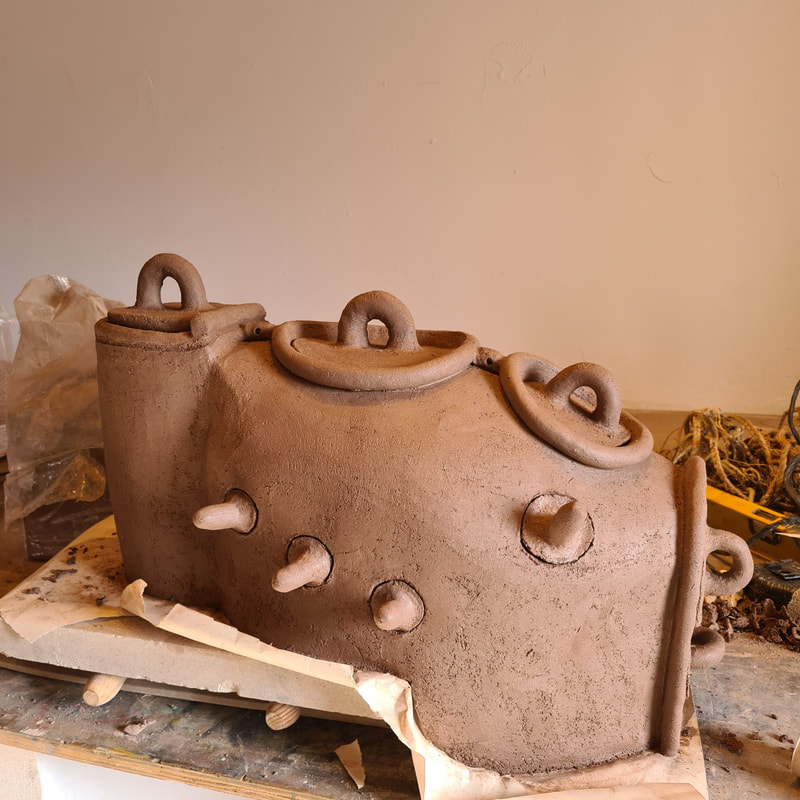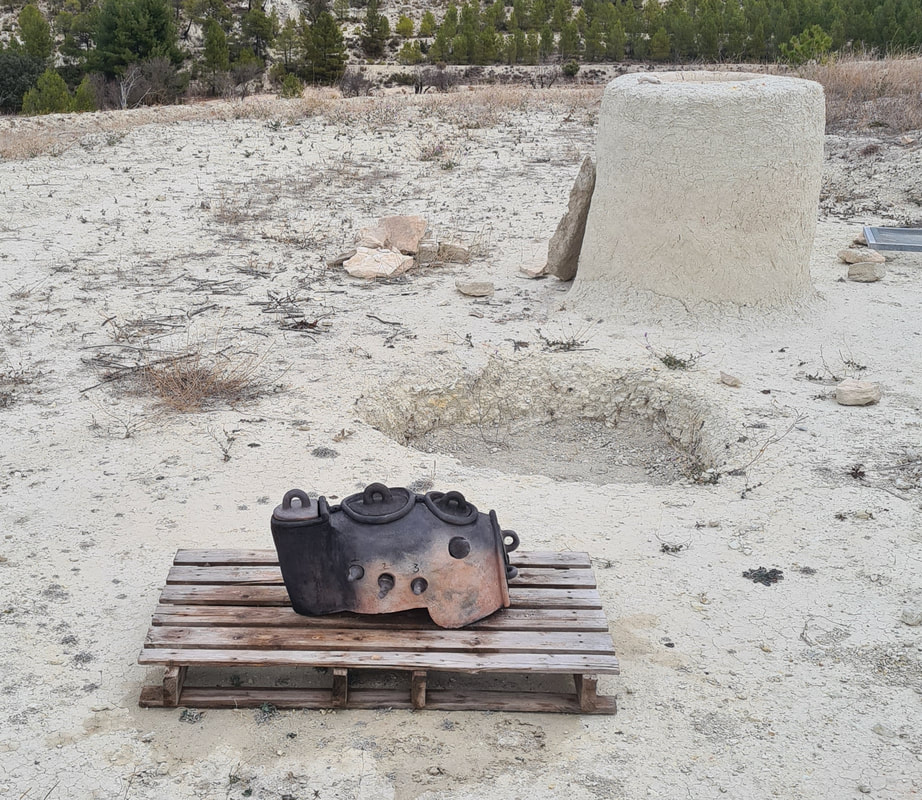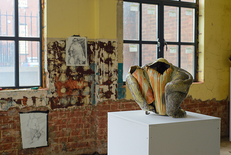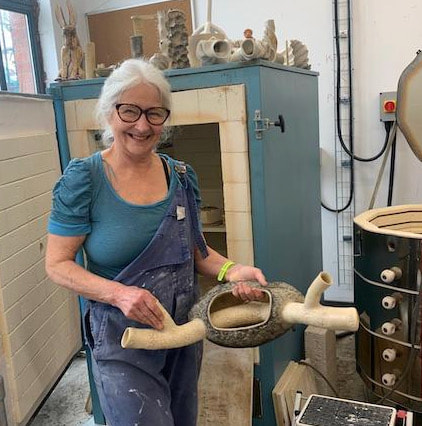Digital Echoes - DYCP Developing Your Creative Practice,
Arts Council Award
https://www.artscouncil.org.uk/
In 2023 I was so thrilled to be successful in my application to Arts Council England for a DYCP award - Developing Your Creative Practice. An award that does what it says on the tin - giving time to develop new ideas without the pressure of an end product. I wanted to explore experimental ways of working with master makers whose work I admired and who I thought could teach me also about delivering masterclasses and attended a workshop in Sauveterre in southwest France with American artist Glen Martin Taylor and a workshop at Pottery Gagliano in Brighton with Spanish artist Alberto Bustos. I also wanted to explore digital sound with both an electroacoustic composer, Adrian Moore from Sheffield University, and Jez Riley French, ecosound/field recording artist.
My first workshop was with Glen Martin Taylor in Sauveterre. This was a steep learning curve. Set in a beautiful ancient village with views of the Pyrenees in the distance and a wonderful river for swimming, it seemed like Paradise. But like paradise, there was a serpent in the mix - or several. the course was billed as a chance to learn about Martin-Taylor's techniques for assembling found objects with pre and post-fired ceramics. In the event, there were very few tools or supplies provided and Martin-Taylor was uniquely unqualified to teach. In fact, Martin-Taylor and the host, Magdalena Groszek, had it in mind that the course was about therapy, which was not mentioned in any of the communications. It was a very difficult week, quite traumatic. However, despite the lack of tuition and equipment, and possibly fuelled by anger and frustration, I was able to produce work which I found very exciting and new for me - see photos below. The first piece, 'Post Truth Barbie' has now been accepted for the Royal Society of Sculptors Summer Show https://sculptors.org.uk/awards/summer-show which feels like some kind of
vindication of the trauma I and the other participants, some of whom had travelled halfway across the world, went through. It was certainly a lesson in how not to run a masterclass, highlighting the need for adequate prep, organisation, tools and equipment and transparency of aims. And a test of resilience in the face of disappointment and frustration.
I also made lifelong friendships with the other participants, expanding my contacts across the world. Out of the shared frustration came a huge sense of bonding and support, and the possibility of collaboration in the future.
Sculptures below were made with found materials - pig bones (charred for effect), disassembled shaving brushes, Barbie doll parts, found rope and string, pottery shards, vintage religious book and solder, and wire cleaning and polishing brushes.
vindication of the trauma I and the other participants, some of whom had travelled halfway across the world, went through. It was certainly a lesson in how not to run a masterclass, highlighting the need for adequate prep, organisation, tools and equipment and transparency of aims. And a test of resilience in the face of disappointment and frustration.
I also made lifelong friendships with the other participants, expanding my contacts across the world. Out of the shared frustration came a huge sense of bonding and support, and the possibility of collaboration in the future.
Sculptures below were made with found materials - pig bones (charred for effect), disassembled shaving brushes, Barbie doll parts, found rope and string, pottery shards, vintage religious book and solder, and wire cleaning and polishing brushes.
My second workshop was with Alberto Bustos (www.albertobustos.es/en/) at Pottery Galliano in Brighton, UK. The opposite of the previous workshop, Alberto had thought of everything and was highly organised and willing to share techniques. He introduced the large class to various of his many unconventional handbuilding techniques combined with quite complicated methods of surface colour decoration with underglazes/transparent glaze mix, with the percentage of underglaze colour far outweighing the glaze amount, the opposite of standard practice. this enables him to be able to have glaze colour over the whole piece as there is not enough glaze content to fuse to the kiln shelves. It's an interesting idea which I have not applied to my own work as yet, but may do in the future. As I work with oxides and not underglaze colours, they behave differently and I am currently exploring other methods using shells and wadding. Alberto's method also allows for once firing because of the limited glaze content. I am currently developing brush on glazes for once firing.
Alberto's approach was a fantastic model for workshop delivery, and the participants an international mix, again leading to possible future international as well as national collaborations.
Alberto's approach was a fantastic model for workshop delivery, and the participants an international mix, again leading to possible future international as well as national collaborations.
Over the year I have been developing new work incorporating found materials. Rope, cord, wood, soldering, shards, rusty metal tools and hair have become key elements in the work. Some of the work is old work repurposed which is a new direction in my work.
I have also been working with Adrian Moore, Professor of Electroacoustic Music at Sheffield University, researching the processes and parallels of creating digital recording versus creating sculpture - how do the two creative practices compare and what do they share? This has involved a lot of discussion and reading - I am not sure I fully understood the meaning of electroacoustic sounds before I started the project, so it has been a steep learning curve, with much still to learn. I am also not great with technology, so progress has been slow. Adrian is still working out the technical logistics of incorporating sound in my work. The idea is that the mechanism for producing the sound is not visible and can be managed remotely. This will be truly put to the test at Sheffield University's Festival of the Mind in September where Adrian and I will be producing several sound sculptures for exhibition at Millennium Gallery in September - festivalofthemind.sheffield.ac.uk/
Photos below show the exchange of practice with Adrian making his first pot since school!
Photos below show the exchange of practice with Adrian making his first pot since school!
I also did Field Recordings with Jez Riley French jezrileyfrench.co.uk/ Jez's specialism is the 'hidden sounds' or sounds we don't give attention to, which echoes my interest. I specifically wanted to record underground and underwater sounds. The idea is for these to be inside my sculptures, barely audible, which take the viewer by surprise. I was astonished at the sounds we were able to record - ants going about their business, and rubbing their legs together (stridulation) and underwater creatures appearing to be munching their way through some treat. It has also been a lesson in looking and listening so carefully, and having patience in abundance. And not leaving the insect repellent behind! However, I was also very frustrated with my lack of technical aptitude in learning to use the equipment and in editing, and I have a lot of work to do on that score, though I am much better than I was!
resonance_-_inside_a_sculpture.mp3
reeds_river_don.mp3
the_daily_life_of_ants.mp3
resonance_-_inside_a_sculpture.mp3
reeds_river_don.mp3
the_daily_life_of_ants.mp3
































 RSS Feed
RSS Feed
